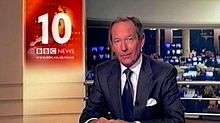BBC News at Ten
| BBC News at Ten | |
|---|---|
 The current programme titles | |
| Also known as | 'BBC Ten O'Clock News' |
| Created by | BBC News |
| Presented by | |
| Theme music composer | David Lowe |
| Country of origin | United Kingdom |
| Original language(s) | English |
| Production | |
| Location(s) | Studio E, Broadcasting House, London |
| Running time | 45 minutes |
| Release | |
| Original network | BBC One |
| Picture format | |
| Original release | 16 October 2000 – present |
| Chronology | |
| Preceded by | BBC Nine O'Clock News |
| Related shows | |
The BBC News at Ten—also known as the BBC Ten O'Clock News or the Ten O'Clock News—is the flagship evening news programme for British television channel BBC One and the BBC News channel. It is presented by Huw Edwards, and deputised by Fiona Bruce. It is the final comprehensive news programme of the day on BBC One. The programme was controversially moved from 9:00pm on 16 October 2000. The main presenter simultaneously holds the lead presenter role for major events, election night (from 2015) and breaking news for BBC News.
It is broadcast Monday to Sunday at 10:00pm. It features twenty-five minutes of British national and international news, with an emphasis on the latter. On weekdays, it incorporates around seven minutes of news from the BBC regions around the country at approx 10:25pm to 10:35pm weekdays or 10:15 to 10:25 weekends, which is then followed by a national weather forecast. During the first three months of its revival, ITV News at Ten averaged 2.2 million viewers compared with an average of 4.8 million viewers watching the BBC bulletin over the same period.[1]
The BBC News at Ten is currently the most watched news programme in Britain, averaging 4.9 million viewers each night.[2]
History
The programme was launched on 16 October 2000, replacing the former BBC Nine O'Clock News, which had been on the air since 14 September 1970. Its launch presenters were Michael Buerk and Peter Sissons. The move to 10 o'clock was a response to the controversial axing of rival broadcaster ITV's News at Ten. ITV reinstated a 20-minute news bulletin at 10pm in 2001, instigating a head-to-head clash with the BBC. The BBC's Ten O'Clock News eventually became the more popular programme, establishing itself on the BBC One schedule for at least six nights a week. ITV's bulletin suffered as a result of poor scheduling, and in February 2004 the bulletin moved to 10:30.[3] In 2008, ITV reinstated News at Ten which remains the BBC's main competitor.

Buerk and Sissons left the BBC Ten O'Clock News on 19 January 2003 to make way for presenters Huw Edwards and Fiona Bruce. To mark this presenter reshuffle, on Monday 20 January 2003 as Edwards and Bruce took over, the bulletin and the rest of BBC One news bulletins were relaunched with a new studio.
Since 5 February 2006, the bulletin has been simulcast on the BBC News channel as part of the BBC Ten O'Clock News Hour. This consists of the BBC One bulletin for the first half hour, with the second half coming from the News channel studio, which is usually presented by Clive Myrie Monday-Thursday and Martine Croxall Friday-Sunday. It includes a paper, sport and business review.
On 21 April 2008 the programme, along with the rest of BBC News, underwent a graphical refresh and moved into a refurbished studio (N6). It also changed its name to the BBC News at Ten.
After the regional news, there is a weather forecast from the BBC Weather Centre: presenters include Rob McElwee, Peter Gibbs, John Hammond and Philip Avery.
BBC News at Ten was named News Programme of the Year at the RTS Television Journalism Awards in 2005, 2009 and 2010.
The programme, along with the BBC News channel and the other BBC One bulletins, moved to Broadcasting House and began broadcasting in high-definition on 18 March 2013.[4]
Following a five-month trial during the run-up to the 2015 general election, it was announced that the BBC News at Ten will be permanently extended by ten minutes between Monday and Thursday from January 2016.[5]
Out of studio presenting
As well as presenting from the main studio, the main presenters are called upon to present on location when major stories break. For example, Huw Edwards reported live from Washington for the 2008, 2012 and 2016 US Presidential Elections and has presented live from Basra at the withdrawal ceremony. He also regularly presented from Westminster, as well as from Edinburgh (at times when the referendum for Scottish independence was being developed).
During the 2012 Summer Olympics, presenters also made use of BBC's makeshift studios overlooking the Olympic Park at Stratford. George Alagiah presented from L'Aquila in April 2009, Haiti in 2010, Egypt in 2011 and from Tacloban in 2013.
Presenters
| Years | Presenter | Current role |
|---|---|---|
| 2003–present | Huw Edwards | Main presenter (Monday-Thursday) |
| 2003–present | Fiona Bruce | Main presenter (Friday), Relief presenter |
| 2000–present | George Alagiah | Relief presenter |
| 2003–present | Sophie Raworth | |
| 2007–present | Emily Maitlis | |
| 2009–present | Kate Silverton | |
| 2010–present | Mishal Husain | |
| 2014–present | Jane Hill | |
| 2014–present | Reeta Chakrabarti | |
| 2015–present | Clive Myrie |
Former presenters
If there is no position before the years of being a presenter, then this newsreader was either a relief presenter or occasional guest stand-in presenter.
Main
- Michael Buerk (Main presenter, 2000–2003)
- Peter Sissons (Main presenter, 2000–2003)
Relief
- Darren Jordon (2003–2006)
- Dermot Murnaghan (2004–2007)
- Sian Williams (2004–2013)
- Natasha Kaplinsky (2006–2007)
- Jon Sopel (2006–2007)
- Ben Brown (2007)
See also
References
- ↑ BBC wins the News ratings battle Media Guardian, 17 April 2008
- ↑ "News viewers turned to BBC in 2007". BBC Press Office. 7 December 2007.
- ↑ https://books.google.ie/books?id=f0P5DcwdNw4C&pg=PA206&dq=itv+news+at+when&hl=en&sa=X&ei=-8OCVdqLIYGzUc2SjfAK&ved=0CDIQ6AEwAw#v=onepage&q=itv%20news%20at%20when&f=false
- ↑ "BBC News' television output moves to new studios at Broadcasting House". BBC. 2013-03-18. Retrieved 2013-03-18.
- ↑ "BBC News at Ten to extend by 10 minutes". BBC. 2015-12-10. Retrieved 2015-12-11.